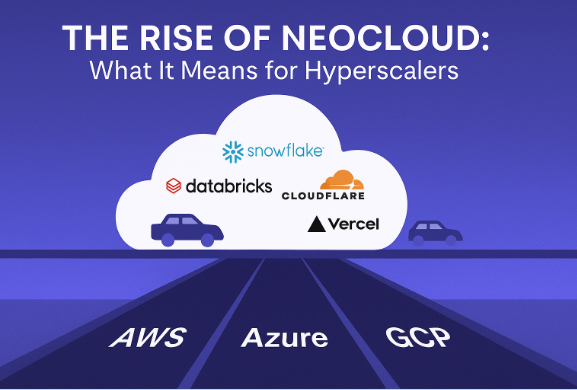
History has a funny way of repeating itself. Empires always look invincible — until they don’t. The British Navy once ruled the seas. IBM mainframes once ruled IT. And for the past decade, the big three hyperscalers — AWS, Microsoft Azure and Google Cloud — have looked just as untouchable. Their logos tower over earnings reports, their data centers span the globe, and their developer ecosystems swallow entire industries.
But just beneath their feet, a new category of challengers has been rising. Some call it “Neocloud.” It’s not about building the biggest regions or the cheapest VMs. Neocloud is about developer experience, opinionated platforms and abstractions that free builders from the sprawl and complexity of hyperscaler menus. If the hyperscalers are the highways of the cloud, Neoclouds are building the on-ramps — and in some cases, entirely new vehicles.
Defining Neocloud
So what is Neocloud? It’s not SaaS, but it’s not hyperscaler IaaS either. Neoclouds build on hyperscaler primitives, but they wrap them in developer-first experiences, managed services and domain-specific optimizations. They promise the power of the cloud without the pain of navigating 400 different APIs.
Consider Vercel and Netlify, which have made front-end deployment and serverless hosting trivial for web developers. Or MongoDB Atlas, Snowflake, and Databricks, which transformed complex data infrastructure into turnkey services with global reach. Cloudflare is another standout: it started as a CDN but has morphed into a networking, security and compute platform that now competes head-on with hyperscalers in edge computing.
These are not niche players anymore. Snowflake commands tens of billions in market cap. Databricks raised at a $43 billion valuation. Cloudflare runs one of the largest global networks in the world. Call it Neocloud, call it the “cloud above the cloud” — whatever the label, the phenomenon is real.
Why Now?
Timing is everything. Neocloud’s rise is not random.
First, developer frustration has reached a boiling point. AWS alone has hundreds of services, many overlapping, many difficult to stitch together. The joke has long been that using AWS requires a PhD in billing. Developers don’t want a menu of primitives; they want paved paths.
Second, enterprises are embracing multi-cloud strategies. Whether for resilience, negotiation leverage, or regulatory compliance, CIOs don’t want all their eggs in one hyperscaler basket. Neocloud providers market themselves as portable by design: They run on top of multiple clouds or abstract the differences away.
Third, the AI boom has created demand that hyperscalers didn’t fully anticipate. Specialized Neoclouds — vector databases, AI-native infrastructure providers, GPU cloud startups—are stepping in to serve the surge. Hyperscalers sell raw GPUs, but Neoclouds package them with optimized developer frameworks and APIs.
Finally, capital markets have rewarded Neoclouds. While hyperscalers are under regulatory scrutiny for dominance, Neocloud players are viewed as disruptors. Snowflake’s IPO, Databricks’ funding rounds, and Cloudflare’s relentless growth all show Wall Street has an appetite for specialist clouds.
Hyperscalers Strike Back
The hyperscalers aren’t blind. They still own the substrate: compute, storage, and networking at a global scale. Every Neocloud player ultimately runs on someone’s hyperscaler bill.
AWS has tried to fight back with developer-friendly services like Amplify and App Runner. Microsoft has leaned on Azure OpenAI to offer a differentiated AI experience. Google Cloud keeps pushing AlloyDB and other managed services to mirror the specialized appeal of Neocloud databases.
But here’s the catch: Hyperscalers struggle with agility. They’re designed for breadth and scale, not depth and simplicity. Their pricing is designed for consumption, not for delight. They can mimic features, but not always the focus. Neoclouds live or die by developer love; hyperscalers live by enterprise contracts.
So hyperscalers respond the way incumbents always do: bundling, discounts, “all-in” incentives to keep workloads from straying. That will work for some CIOs, but for developers and business units who crave speed, Neocloud is often the path of least resistance.
Opportunities and Risks for Neocloud
The opportunity is obvious: Own the developer experience, while the hyperscalers remain the commodity layer. If Neocloud providers can continue abstracting away hyperscaler complexity, they’ll keep capturing workloads higher up the stack.
The risks are also clear. Neoclouds still depend on hyperscalers for their raw substrate. If AWS or Azure decides to squeeze margins on underlying compute, Neocloud economics could be tested. And hyperscalers are ruthless copycats — how many times has AWS cloned a partner’s service and bundled it for free?
Neoclouds must also prove they can scale profitably. It’s one thing to offer a magical developer experience at $100 million ARR; it’s another to sustain it at $10 billion while still paying AWS for the servers underneath.
What This Means for Enterprises
For CIOs, the rise of Neocloud means more choice — but also more fragmentation. Today’s platform teams don’t just manage Kubernetes clusters on AWS. They also manage Snowflake for data, Cloudflare for networking, Databricks for ML pipelines, Vercel for web workloads. The sprawl is real.
Security, governance and observability become harder across this “poly-cloud.” Enterprises need new strategies for identity, cost control, and policy enforcement that span both hyperscalers and Neoclouds. The winners will be those who blend the best of both: hyperscalers for raw scale, Neoclouds for velocity and focus.
Shimmy’s Take
We’ve seen this movie before. Hyperscalers are today’s mainframes — dominant, indispensable, but not untouchable. Neocloud is the client-server revolution of our era: faster, lighter, closer to developers and often better aligned with business needs.
Neocloud is not hype. It’s how developers actually want to consume cloud in 2025 — opinionated, streamlined, multi-cloud by default. The hyperscalers won’t disappear. They’ll keep running the global substrate. But their monopoly on innovation is cracking.
The next decade won’t be hyperscalers vs. Neocloud. It will be a mixed economy, where hyperscalers lay the highways and Neoclouds build the on-ramps. The real question isn’t whether Neocloud will rise — it already has. The question is how fast enterprises will embrace it, and how the hyperscalers will adapt when they’re no longer the only game in town.


